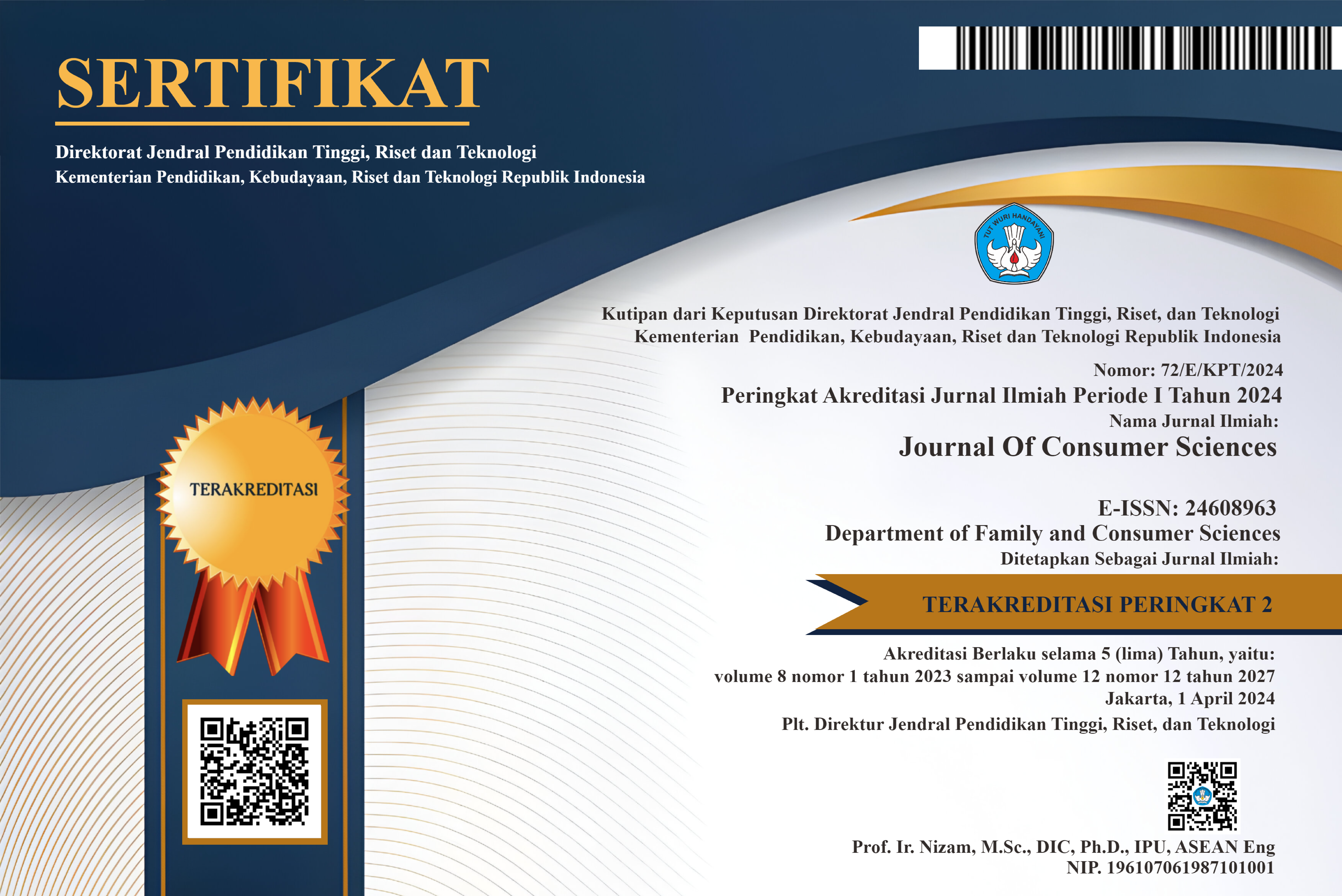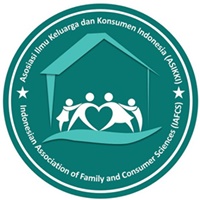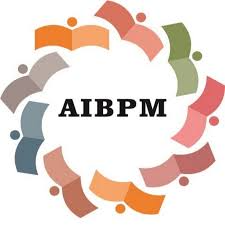Author Guidelines
Manuscripts must be original, have not been published previously in any scientific journal, are not being submitted for publication elsewhere, and will not be submitted to any media during the review process, unless the authors have officially withdrawn the manuscripts from Journal of Consumer Sciences.
Please note the important points below before submitting the article:
- Manuscript are written in English and use standard scientific usage. If manuscripts are written in English, authors especially whose first language is not English should consult the manuscript with Professional Proofreading service before submitting and attach certificated it to Journal of Consumer Sciences.
- Manuscripts should be prepared in Microsoft Word format (doc).
- Manuscript are prepared in A4 paper and 1.15 spacing.
- Manuscript should be typed 1,15 lines spaced with information
Title, Authors, Institution/company where the author works (affiliation detail information use to zip code, and road/building), and include contact email to correspondence, Abstract, Introduction, Literature review, Conceptual framework, Methods, Findings, Discussion, Conclusion, Recommendation, References
Adapt the manuscript to the following paper template : Paper Template
- Tables, graphs and figures used should be easy to read (high quality) and referenced in each explanation. The maximum number of tables is 6.
- Figure titles are the same as table titles. Can stand alone separate from the text
- Each table and figure should be mentioned and narrated first before the table and figure. Do not discuss all the numbers in the table
- Structure and content of manuscripts in Journal of Consumer Sciences refer to American Psychological Association (APA) Style 7th edition.
- Bibliography must use Mendeley/Zootero reference manager before submitting manuscript
- Authors submit electronically through the online system: https://journal.ipb.ac.id/index.php/jcs/how-to-submission by sending the manuscript and author profile. If the author finds difficulty in submit the manuscript electronically, author can contact administration staff by e-mail (jcs.ikkipb@gmail.com)
Manuscript Structure and Content
Title. The title must be brief, clear, specific and informative which reflect the article content. The length of the title maximum 14 words. Each word of the title should begin with capitalized letter.
Author's Name. The preferred form of an author’s name is first name, middle initial(s), and last name. Author’s name should appear in the order of their contributions. Author’s name is written without titles and degrees.
Author’s Institutional Affiliation. The affiliation identifies the location where the author or authors were when the research was conducted. Name of institution(s) where the research was conducted must be accompanied with full address including institution/department, city, zip code, country, and e-mail.
Abstract. Abstract must contain background, purpose, methods, findings, conclusions, research implications. The abstract should be written in English, in one paragraph and no more than 250 words. Keywords should be written in no more than 5-7 words and sorted alphabetically.
- Introduction. The introduction should explain the problem, previous research that addresses the variables under study, so that the novelty of the research can be presented. Present the theory used in the research, the output to be achieved from the research. Each objective must be answered in the conclusion
- Literature Review. The literature describes in the form of subchapters: the theory used, the variables studied, the relationship between variables which ends with a hypothesis.
- Conceptual Framework. In this section the author reviews in general based on previous empirical studies. The author creates a conceptual framework image with the analyzed variables accompanied by a hypothesis
- Methods. Methods consist of the following aspects and should clearly explain: research design, sampling, measurement, data collection, and data analysis. It can be written in 5 sub-chapters as follows:
4.1 Research Design: Provide an explanation of the research design and location of the study.
4.2 Sampling: Provide an explanation of the respondent sampling technique, the planned target number and the basis for its determination. The number of respondents obtained and how many were analyzed. State the response rate: the number planned, collected and analyzed. Response rate is the number of (sigma) collected/taken divided by (sigma) collected X 100%.
4.3 Measurement: Contains an explanation of the instruments used regarding the reference. The author explains the variables, indicators referring to the source, the scale used, the operational definition of each variable (in the table), and Cronbach alpha.
4.4 Data Collection: The data collection process is described in detail, timing of the study, medium of collection. Should be applicable to other researchers without meeting the researcher
4.5 Data Analysis: Describe each objective answered with what analysis was used. - Findings. Findings, explain the results of the research using tables, graphs, or pictures. This should be a concern for the author to explain the data not just read it.
- The title of the figure is the same as the title of the table. Can stand alone, separate from the manuscript
- Each table and figure should be mentioned and narrated before the table and figure. Do not discuss all the numbers in the table
- Findings present the empirical results of the research conducted. It is strongly recommended that the findings be written in different sections for each variable or result.
- Images should be of high quality (1200 dpi for line art, 600 dpi for grayscale and 300 dpi for color, at the correct size). Images must be provided in one of our preferred file formats: EPS, PS, JPEG, TIFF, or Microsoft Word (DOC or DOCX) files are acceptable for images that have been drawn in Word.
- Discussion. Discussion should show relevance between the results and the field of investigation and/or hypotheses and supported by references or previous empirical researches.
- If the SEM results are discussed specifically in the discussion by explaining the hypothesis findings, then followed by their interpretation. Then it is discussed why it is significant/not significant. The discussion can be linked to the indicators that have the greatest contribution. Discuss in depth then link to previous research findings that are in line with research findings or different with an explanation of why they are different.
- Results that already described in the results section should not be repeated in the discussion section. Comparison with other research results also serves to indicate the position of the research conducted in the middle of the discourse of relevant topics. Also write down the limitations of the study. The writing can be made in sub-chapters as:
Example :
6.1 The effect of health care on attitudes toward behavior
6.2 The effect of perceived physical benefits on attitude toward behavior
6.3 ….
6.4 Managerial Implication
Explain what recommendations are given from the statistical results or other tools. For statistics, only significant recommendations are given. If --> significant --> there should be implications. Advice can be given to businesses, government, or other parties.
6.5 Theoretical Contribution
Describe what the research contributes to the theory used. Does it strengthen or is there something different from the previous theory and what gaps does this research fill in the theory referenced?
6.6 Limitations
Explain the limitations of the research that was designed but could not be conducted. Limitations can be in terms of methods (sampling, number of respondents, data collection methods, area coverage etc.). It can also be in terms of the object of research
- Conclusion. Conclusions must be in accordance with the objectives made brief, clear, and concise.
- Recommendation. Recommendation for improvement for limitations and future research
Acknowledgment (if any) to person(s) or institution(s) who help the experiment should be stated.
References:
- References are preferably publications from the last 5 years with 80% from journals, listed alphabetically by author's last name and year of publication.
- Complete the doi of each journal, if there is no doi, write the url of the article. If taking from research gate, do not enter the research gate link but must go directly to the journal url directly.
- Book citations are strongly discouraged.
- Write a complete bibliography according to APA style.
- References should also come from the Journal of Consumer Science (if relevant).
- Each article must cite at least 3 articles from the journal of consumer sciences. Please check the topics that are in line with the article.
- Check any references to original sources (author name, volume, issue, year, DOI number). Please use the Reference Manager Application like Mendeley, Zotero. JCS adapts reference writing in the APA style model. Some examples of references are presented below:
- Book
Format:
Author, A. A. (Year). Book title (edition, if any). Publisher. DOI or URL (if available)
Example:
Kotler, P., & Keller, K. L. (2016). Marketing management (15th ed.). Pearson.
- Journal Article
Format:
Author, A. A., Author, B. B., & Author, C. C. (Year). Title of article. Journal Name, Volume (Edition), page. https://doi.org/xx.xxxx
Example:
Smith, J. A., & Brown, L. K. (2020). The effects of social media on youth development. Journal of Social Research, 45(3), 123-135. https://doi.org/10.1234/jsr.2020.56789
- Newspaper or Magazine Article
Format:
Author, A. A. (Year, Month Date). Title of the article. Name of Newspaper/Magazine. URL
Example:
Doe, J. (2023, April 15). The future of sustainable energy. The New York Times. https://www.nytimes.com/2023/04/15/sustainable-energy.html
- Online Source (Website)
Format:
Organization/Writer, A. A. (Year, Month Date). Title of the page. Website name. URL
Example:
World Health Organization. (2021, June 15). Mental health and COVID-19. WHO. https://www.who.int/mental-health-covid19
- Thesis/Dissertation
Format:
Author, A. A. (Year). Title of thesis/dissertation (Unpublished thesis/dissertation). Name of Institution.
Example:
Johnson, M. T. (2019). The impact of digital tools on education (Unpublished master's thesis). University of California, Berkeley.
- Source from Edited Book Chapter
Format:
Author, A. A. (Year). Chapter title. In A. Editor & B. Editor (Eds.), Book title (pages). Publisher. DOI or URL (if available)
Example:
Hall, S. (2014). Cultural identity and diaspora. In P. Williams & L. Chrisman (Eds.), Colonial discourse and post-colonial theory (pp. 222-237). Routledge.
About the Authors. In this section, all authors write where they work or graduate from which university. The scientific field being taught. each author's email address. (each author is made one paragraph each).
Corresponding Author Photo. The author hopes to use a formal photo with a blue background
Public Interest Statement. Contains the challenges faced in your research.
Detail information, please download the form below:












